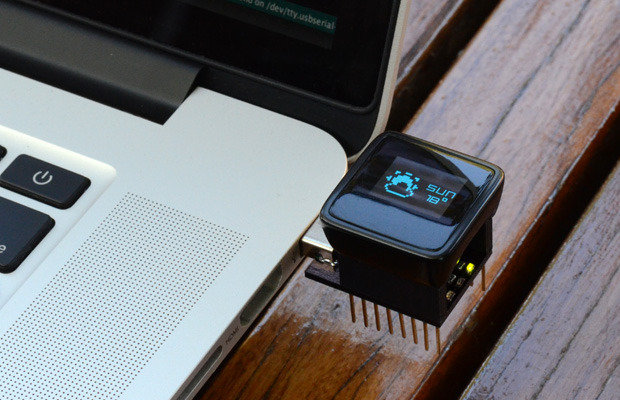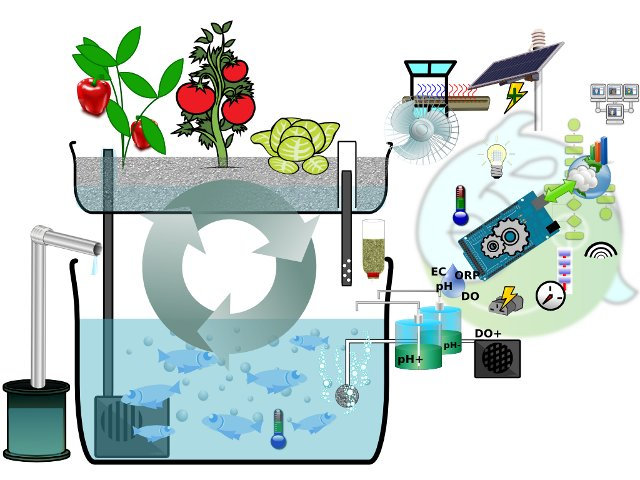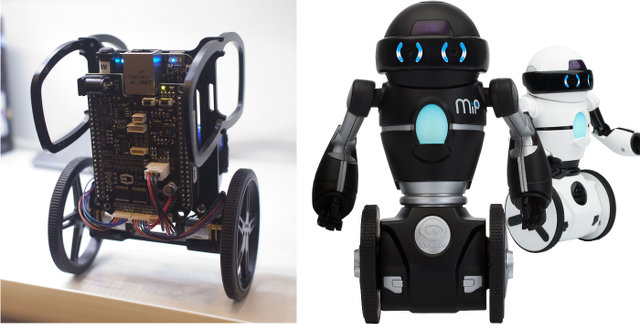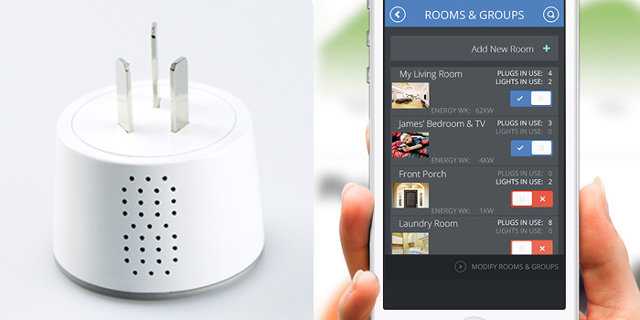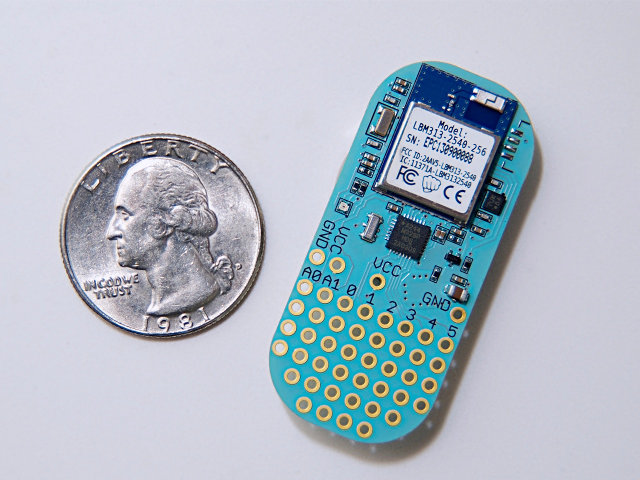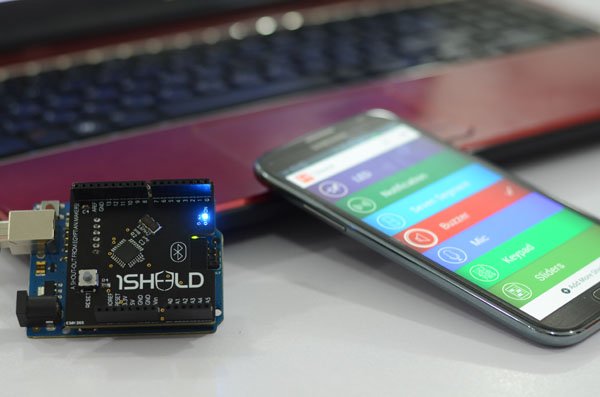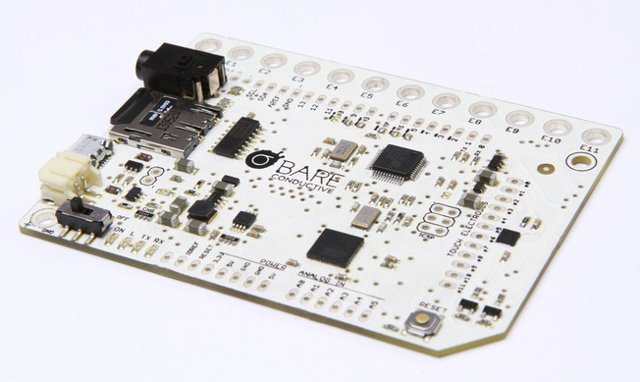Digispark Pro is yet another small Arduino compatible board, but it costs only $14, and over 25 small form factor shields for Wi-Fi, BLE, mesh networking, etc.. are available for the platform. Let’s get straight into the hardware specs: MCU – AVR MCU @ 16 Mhz with 16KB Flash Memory (14.5K+ after bootloader) I/Os 14 I/O pins (2 shared with USB) I2C, true SPI, UART, LIN, and USI ADC on 10 pins 3 PWM Channels (which can be assigned to a selection of pins) USB – Micro USB for debugging, communication and power Misc – One button usable as reset, program, or user button, Power and Test/Status LEDs, user accessible solder jumpers to disable LEDs, and other features for lower power consumption Power – 5V via micro USB, or External Source – 5v or 6-16v (automatic selection). On-board 500ma 5V regulator Dimensions – 26.7mm x 18.3mm The board is compatible […]
MicroView is a Tiny Arduino Compatible Board with an OLED Display (Crowdfunding)
Last year, we’ve been presented with many small Arduino compatible boards such as MicroDuino, RFDuino, BLEDuino, Spark Core, Olimexino-Nano and more… All these boards have been own strength and connectivity options, but if you want to see what going on in your board, you’d either need to connect it to your computer, or connect some LEDs or an external display. Geek Ammo’s MicroView fixes that by providing an Arduino compatible board nicely combined with a built-in OLED display. This allows you to display stats, weather, play games, create wearable projects (watch, necklace), and all sort of other projects that may require a small display. MicroView specifications: MCU – Atmel ATmega328P @ 16 MHz with 32KB flash, 2 KB SRAM, and 1KB EEPROM Display – 64×48 OLED Display Digital I/O – 12 (of which 3 provide PWM output) Analog Input – 6 Operating Voltage: 5V Input Voltage: 3.3VDC to 16VDC, no […]
DIY Farm & Garden Automation with Arduino and APDuino Project
You would like to start to grow your own vegetables but you don’t really have enough place and/or time to take care of your garden. No problem! Just go vertical and automate your garden with an Arduino Mega, an Ethernet shield, and lots sensors and valves. That’s basically what Rik Kretzinger, who grew up on a Christmas tree farm, and has a major in horticulture, has done at his home. This whole system use a farming technique called aquaponics, mixing aquaculture (raising fish in tanks) and hydroponics (cultivating plants in water), and except planting and harvest, is mostly automatized. The hard part is to set it up. The firmware is based on APduino “Internet-of-growing” open source project that runs on Arduino Mega to gather data from sensors (humidity, temperature, pH, light…) and control the valve. Rik’s system also upload data automatically to Xively cloud so that he can monitor his […]
The Open Source Robots Invasion Has Begun: BeagleMiP, uARM, and PiddyBot
In the last few days, I’ve come across three affordable open source robots either based on BeagleBone Black, or Arduino compatible boards, and I’m sure there are many other projects out there for people interested in getting started with robotics without breaking the bank. BeagleMiP Self-balancing Robot I’ve found out the first robots from a long armdevices.net video showing two Mobile Inverted Pendulum (MiP) robots, able to stand on two wheels, designed by the Coordinated Robotics Lab of The University of California, San Diego: BeagleMiP educational robotics development kit from Strawson Design. The kit features the BeagleBone Black board with Texas Instruments Sitara ARM Cortex A8 processor and Novus Robotics Cape, an add-on board that provides 9-axis IMU (Accelerometer, Gyro, Magnetometer), 6 PWM connectors to power servos or brushless ESCs, 2 user-accessible buttons and 2 LEDs, a cell balancer & overvoltage protector, H-bridges to drive 6 DC Motors, and connectors […]
$27 Plugaway Wi-Fi Smart Sockets Support Australia, China, Europe, U.K. or U.S. Standards (Crowdfunding)
Until now, Broadlink SP1 was the cheapest ($32) Wi-Fi smart socket I found. It supports Australian and Chinese plugs, and Android and iOS smartphones. The two main downsides is that the application is in Chinese by default (English can be installed via a firmware upgrade), and although the top of the socket support international plugs, the plug of the device only support Australian / Chinese standard, and you may need an adapter to connect the device to your wall socket. There’s now a similarly priced option in Kickstarter called Plugaway that supports Australia, China, Euro, U.K. or U.S. standards, can measure power consumption, dim lights, and comes with Android and iOS apps, with Windows planned for a future release. Specifications: MCU – Atmel ATmega128 up to 16MHz with 128 KB flash Wi-Fi – Marvell 88W8686 Wi-Fi 802.11 b/g chip, to be upgraded to support 802.11n for longer range Current sensor […]
LightBlue Cortado is an Arduino Compatible Board Programmed Wirelessly via Bluetooth LE (Crowdfunding)
We’ve already seen several Bluetooth Low Energy (BLE) Arduino compatible boards being crowd-funded such as RFDuino and BLEDuino, but there’s now another board designed by Punch Through Design: LightbBlue Cortado. The board is programmed wirelessly directly via Bluetooth LE, instead of USB as in the two aforementioned boards, which means programming via iPad or Android tablets becomes more convenient. Here are the technical specifications of the board: MCU – Atmel ATmega328P @ 8MHz with 32KB Flash, 1KB EEPROM, 2KB SRAM Bluetooth – LBM313 Module with Texas Instruments CC2540, 256 KB Flash. Bluetooth range: 30.5m. Power consumption in sleep mode: 0.9μA I/O – 4 PWM pins, 2 Analog inputs, 8 GPIO, I2C and SPI Sensor – 3-Axis Accelerometer Misc – RGB LED, protoboard section, adhesive backing Power – Coin cell battery. Battery life exceeding one year for low power applications There’s no USB, so the only way to program the board is via […]
1Sheeld Arduino Shield Leverages Your Android Smartphone Hardware
To get started with Arduino, a simple board is enough, with soon, you’ll need to add shields for Wi-Fi, sensors, maybe a small display, etc.. and costs add up. Integreight, an Egyptian startup, had to idea to create a simple shield called 1Sheeld that can leverage your smartphone hardware assets such as Wi-Fi, LEDs, sensors, the display, the speaker, etc.., so you don’t have to spend extra money on shields. Technical Specifications: Runs on an ATmega162 @ 16 MHz Uses a standard HC-06 adapter (Bluetooth 2.0) providing up to 30 feet range (about 9 meters) Uses a modified version of the Firmata protocol Can communicate with Arduino using UART 50mA current draw That’s for the hardware, and there’s also a software platform and Android app to manages the communication between the shield and the smartphone, and select different shields options. You’d have to write your sketch using the company’s library, […]
Almost Anything Can Be A Touch Input with The Touch Board and Electric Paint
Bare Conductive, a British startup, has designed an Arduino Leonardo compatible board with 12 capacitive touch sensors called the Touch Board. You can basically use any conductive material as a touch sensor, but the company’s existing “electric paint” really makes the board come to life, and you can just draw circuit anywhere, be it on paper, your wall, cardboard, and create fun and useful applications. Touch Board specifications: MCU – Atmel ATMega32U4 Microprocessor @ 16 MHz with 32 KB of Flash Memory of which 4 KB is used for bootloader. External storage – MicroSD card slot I/Os: 20 digital I/O pins (3 used for Touch IC and 5 for MP3 IC – can be disabled) 7 PWM channels 12 analog input channels 12 Touch electrodes of which 8 can be configured as extra digital inputs or outputs with PWM capability. (via Freescale MPR121) Audio – Playback and MIDI support via […]



